How to Get Rid of Flying Ants in Your Home, According to Pest Experts

From fruit flies to house flies to fungus gnats, spotting any kind of bug that can buzz about your home is a total pain. But many people don’t realize that one of the most annoying pests to eradicate—ants—can also fly until they see them hovering around indoors.
And nope, they’re not some odd breed. “There are several species of ants that have flying ants in their colonies, such as carpenter ants, fire ants, and pharaoh ants,” says Desiree Straubinger, board certified entomologist and market technical director of Western Exterminator.
Flying ants, known as alates, are sexually mature ants, according to Howard Russell, M.S., an entomologist at Michigan State University. They’re known as the “reproductives” of the colony, which were created by the queen and fed by worker ants. Flying ants typically come together to mate on clear days after rainy weather—emergences known as “nuptial flights,” which occur around summer into early autumn.
Afterward, “males and females come back to the ground and males are done,” says entomologist Roberto M. Pereira, Ph.D., an insect research scientist with the University of Florida. “Normally [males] will die or may be eaten by other insects or birds.” The females will lose their wings and look for a good spot to start a new colony.
What do flying ants look like, exactly?

Compared to your typical worker ants (the ones you see out and about on the ground), flying ants tend to be bigger in size and obviously have wings, Russell says. Most worker ants are female, but flying ants also include males. They can range in color, from black to brown to red.
“Many people confuse flying ants with termites,” Straubinger says. But “termites are generally smaller than ants and their wings are the same length or longer than their bodies.”
Do flying ants bite or sting?
For the most part, flying ants are focused on mating and don’t really care about you. But they do have mandibles (mouth parts) and can technically use them to bite, Russell says.
Depending on the type of ant that’s near you, they can also sting you, Pereira says. In Florida and other warmer climates, an ant called hypoponera punctatissima (a small, yellow-brown species) will sting people. “Other ants may do that occasionally, too,” he says.
One simple of way of determining if a flying ant could potentially harm you: “If a species of ant doesn’t bite or sting, the alates of that species won’t bite or sting either,” says Frank Meek, technical services manager at Rollins. “If the ant species bites or stings, the alates of that species can still bite or sting if they feel threatened.”
How to get rid of flying ants in your home
If you spot flying ants inside your home, don’t panic. While the female could technically start a nest inside your place, Pereira says it’s pretty unlikely. Air conditioning and heating can cause ants to dry up and “die very rapidly inside houses,” he says.
While flying ants should settle down pretty quickly (and the males will die), you can kill them off one by one if they bother you, Pereira says. Traditional ant bait is unlikely to lure them in, so use a swatter, rolled up magazine, or even a vacuum to suck them up.
If you can’t seem to catch them, another easy hack is trying to trap them in sticky tape or fly paper. Simply hang up the paper or ribbon, which is designed to attract and catch flying insects, near any areas you’ve noticed the flying ants hanging out. (If you suspect you have a full on ant problem and the colony is nearby, check out these tips on how to get rid of ants in general.)
You can also keep ants—winged or otherwise—from entering your home by sealing up holes and entry points, Straubinger says. This includes any cracks or crevices in the wall or floor, and openings around windows, screens, vents, or doors.
Support from readers like you helps us do our best work. Go here to subscribe to Prevention and get 12 FREE gifts. And sign up for our FREE newsletter here for daily health, nutrition, and fitness advice.
You Might Also Like

